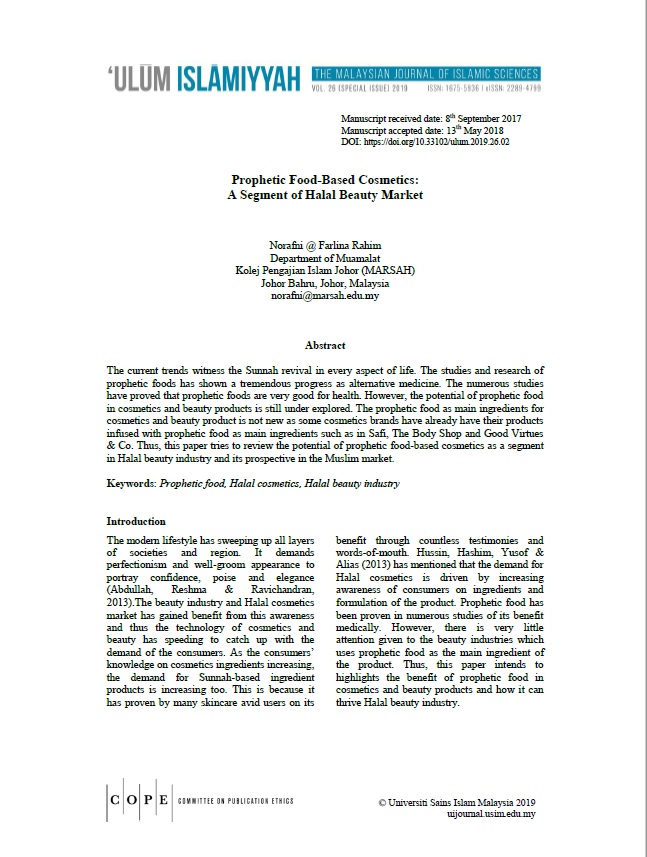Prophetic Food-Based Cosmetics: A Segment of Halal Beauty Market
DOI:
https://doi.org/10.33102/uij.vol26no.88Keywords:
Prophetic food, Halal cosmetics, Halal beauty industry, Shariah, Islam, CosmeticsAbstract
The current trends witness the Sunnah revival in every aspect of life. The studies and research of prophetic foods has shown a tremendous progress as alternative medicine. The numerous studies have proved that prophetic foods are very good for health. However, the potential of prophetic food in cosmetics and beauty products is still under explored. The prophetic food as main ingredients for cosmetics and beauty product is not new as some cosmetics brands have already have their products infused with prophetic food as main ingredients such as in Safi, The Body Shop and Good Virtues & Co. Thus, this paper tries to review the potential of prophetic food-based cosmetics as a segment in Halal beauty industry and its prospective in the Muslim market.
Downloads
References
Abdullah, J., Reshma, N., & Ravichandaran, N. (2013). Behaviour of Indian Consumer towards Skin Care Products (Cosmeceuticals) – A Conceptual Model. International Journal of Advanced Research. Volume 1(5), pp: 512-518.
Abdullah Swidi, Wie, C., Hassan M. G., Al-Hosam, A., & Mohd Kassim, A. W. (2010). The mainstream cosmetics industry in Malaysia and the emergence, growth and prospects of Halal cosmetics. The Third International Conference on International Studies (ICIS 2010), Sintok: Universiti Utara Malaysia
Al Gamdi, K., Al Homoudi, F., & Khurram, H. (2014). Skincare: Historical and Contemporary Views. Saudi Pharmaceutical Journal. 22, pp: 171-178.
Al-Mubarak, T. & Osmani,N.M (2009). Application of Maqasid al-Shariah and Maslahah in Islamic banking practices: An analysis. ResearchGate,
<http://www.researchgate.net/publication/235988767_Applications_of_Maqasid_al-
Shariah_and_Maslahah_in_the_Islamic_Banking_Practices_An_Analysis/file/60b7d51754b8ebeecb.pdf>.
Baltazar, D., Marto, J., Berger, T., Pinto, P., & Ribeiro, H. (2017). The antiageing efficacy of donkey mil in combination with pomengranate extract and UV protection: A traditional ingredient in a modern formulation. House & Personal Care Today, 12(2), pp: 30-32.
Burlando, B., & Cornara, L. (2013). Honey in dermatology and skin care: A review. Journal of Cosmetic Dermatology. Vol. 12(4), pp: 306-313. Available from: https://www.researchgate.net/publication/259200803_Honey_in_dermatology_and_skin_care_A_review [accessed May 27 2018].
Che Man, Y. & Mustafa, S. (2010). Updates of Halal Products Authentication. Presentation slides at World Halal Research Summit 2010, Malaysia: Kuala Lumpur.
Farhangi, H., Ajilian, M., Saeidi, M., & Khodaie, G.H. (2014). Medicinal Fruits in Holy Quran. International Journal of Pediatrics (Supplements 4).Vol. 2 (3-2), pp: 89-102.
Gambles, M.H. (2010). Halal skincare: Beyond…The Halal Journal, pp:36-38.
Ghavamizadeh, M. & Mirzaie, A. (2014). Specifying the Antioxidant Activities of Five Fruits Mentioned in Quran and Sayings (Ahadith). Quran Med, 3(1), 1-6.
Hashim, P, & Mat Hashim, D. (2013). A Review of Cosmetic and Personal Care Products: Halal perspective and detection of ingredients. Pertanika Journals of Science and Technology, 21(2): 281-292.
HDC (2018). Halaalan Toiyyiban. Retrieved from http://www.hdcglobal.com/publisher/cdh_halalan_toyyiban
Hossain, M. (2014). What does Islam say about dieting? Journal of Religious Health. 53(4), pp: 1003-1012.
Hunter, M. (2012, March). The emerging Halal cosmetic and personal care market. Personal
Care, 37-41. Retrieved fromhttp://works.bepress.com/cgi/viewcontent.cgi?article=1021&context=murray_huntesi-
redir=1&referer=http%3A%2F%2Fscholar.google.com.my%2Fscholar%3Fstart%3D
30%26q%3DHalal%2Bawareness%26hl%3Den%26as_sdt%3D0%2C5#search=%22
Halal%20awareness%22
Husain, R., Abd Ghani, I., Mohammad, A. & Mehad, S. (2012. Current practices among Halal cosmetics manufacturer in Malaysia. Journal of Statistical Modelling and Analytic, 3(1), 46-51.
Hussin S.R., Hashim, H., Yusof, R. N., & Alias, N. N. (2013). Relationship between Product Factors, Advertising, and Purchase Intention of Halal Cosmetic. Pertanika Journals of Social Sciences & Humanities, 21 (S): 85-100
Kale, S., Ghoje, P., Ansari, A., Waje, A., & Sonawane, A. (2010). Formulation and in-vitro determination of Sun Protector Factor of Nigella sativa Linn. Seed Oil Suncreen Cream. International Journal of PharmTech Research. Vol. 2(4), pp: 2194-2197.
Kamal, H. (2008). Biotechnology in the Islamic world. The Halal Journal, pp: 38-40.
Khatijah, R. (2008). The problem with cosmetics ingredients. The Halal Journal, pp:34-37.
Lavecchia, R., & Zuorro, A. (2015). Evaluation of Olive Pomace as a Source of Phenolic Antioxidants for the production for Functional Cosmetics. International Journal of Applied Engineering Research, Vol. 10(14), pp: 34405-34409.
Mohd Ali, A., & Mat Said, A. (2012). Socio-economic background and purchasing pattern of natural cosmetic products. Paper presented at UMT 11th International Annual Symposium on Sustainability Science and Management. Malaysia: Terengganu.
Nadia, B. (2018). Rise of local cosmetic brands. New Straits Times. January, 17. Retrieved from https://www.nst.com.my/lifestyle/flair/2018/01/325908/rise-local-cosmetic-brands
Nanocosmetics: A big no-no. (2010, Sept-Oct). Utusan Konsumer, 8
Nur Syazana, U., Mohd Dzulkhairi, M. R., Zairina, A. R., & Muhammad Shamsir, M. A. (2016). Practice of Phoenix dactylifera (Dates) among Residents in Kg. Dato’ Ahmad Razali, Dengkil, Selangor: A Preliminary Study. International Journal of Social Science and Humanity, Vol. 6 (9), pp: 681-684.
Six beauty products taken off the shelves. (2010, March 5). The Star, N24.
Sultan, Z., and Khasawneh, A. (2015). Facial Beauty: A Collection of Glass Kohl Containers from the North of Jordan. Mediterranean Archaeology and Archaeometry, Vol. 15 (1), pp:83-93.
Teng, P.K. & Wan Jamaliah, W.J. (2013). Investigating student awareness and usage intention towards Halal labelled cosmetics and personal care products in Malaysia. Paper presented at 4th International Conference on Business and Economic Research (4th ICBER 2013), Indonesia: Bandung.
Thomson Reuters & Dinar Standards (2016). State of the Global Islamic Economy Report 2016/17. Dubai, United Arab Emirates.
Zaahira, M. (2008). Islam and the obsession with beauty. The Halal Journal. pp: 30-33.

Downloads
Published
How to Cite
Issue
Section
License
If the article is accepted for publication, the copyright of this article will be vested to author(s) and granted the journal right of first publication with the work simultaneously licensed under the Creative Commons Attribution-NonCommercial 4.0 International License, unless otherwise stated. Anyone may reproduce, distribute, translate and create derivative works of this article (for both commercial and non-commercial purposes), subject to full attribution to the original publication and authors. The full terms of this licence may be seen at https://creativecommons.org/licenses/by-nc/4.0/.






